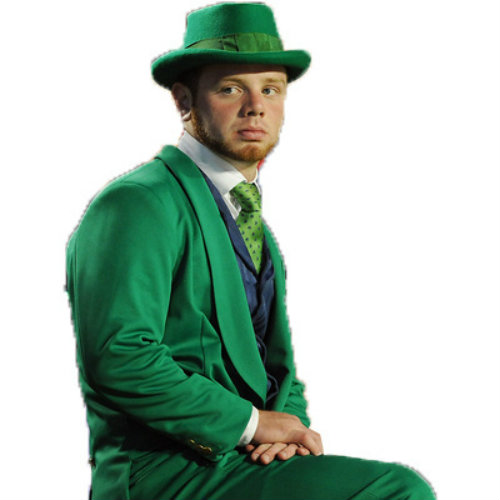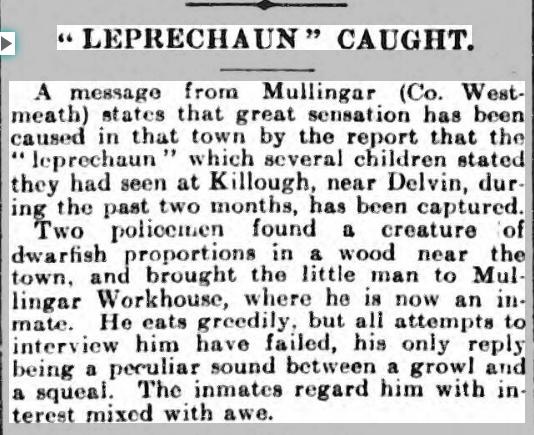Catching a Leprechaun: A Modern Morality Tale March 19, 2019
Author: Beach Combing | in : Modern , trackbackThere are several reports from early twentieth-century Ireland of crowds of boys chasing leprechauns. This is the best attested of what we might call ‘leprechaun riots’ (named for ghost riots):
Belief in the fairies, the ‘good people’ is still prevalent in many of the country districts in Ireland. During the past few days the superstition has been revived in North-West Meath, owing to certain mysterious occurrences in the Killough district. It seems that a strange creature has been observed recently in that neighbourhood. Several persons claim to have seen it, and describe it as a man of dwarfish proportions, and clad in red, with a small peaked cap, this being, it may be remarked, the traditional appearance of a Leprechaun… The affair has created the greatest excitement, especially as the belief is that if a person is so fortunate as to capture a leprechaun unawares the leprechaun will, a condition of his release, lead his captor where a secret pot gold lies buried. (21 Apr 1908), 3
I did not realize this when, many years ago, I wrote a post on the leprechauns of Liverpool, but this treasure fever is presumably at the bottom of the crowds of grimy boys.
There were still more reports in May 1908.
The mystery grows around the ‘leprechaun’ which is elated to have been seen by several of the school children of Killough, Co. Westmeath. This week the little creature is reported to have made several appearances in the district, and these are much [?] by the people. It is understood a school teacher has closely questioned the children about the matter, and they adhere to their stories, and declare they have seen the leprechaun and minutely describe its appearance and conduct. On one occasion some of the children pursued it to a moat hard by a churchyard, where it disappeared. Its clothing is described on most of its appearances as that which tradition gives to it, but on one occasion lately it was seen sitting under a hedge. In place of the red and green clothes and grey stockings it was clad altogether in white, and played on a small harp, from which sweet music was called forth by the touch of tiny fingers. The matter has naturally given food for much gossip, wonder, and speculation in the district.
But after this the reports taper out. So another bizarre fairy story that would sink into local folklore? Well, not quite. Fast forward three months to August. This piece is so striking that I have given a screen capture.
‘Leprechaun Caught’: A message from Mullingar (Co. Westmeath) states that great sensation has been caused in that town by the report that the ‘leprechaun’ which several children stated they had seen at Killough, near Delvin, during the past two months, has been captured. Two policemen found a creature of dwarfish proportions in a wood near the town [a later report reveals he was found in a farmyard], and brought the little man to Mullingar Workhouse, where he is now an inmate. He eats greedily, but all attempts to interview him have failed, his only reply being a peculiar sound between a growl and squeal. The inmates regard him with interest mixed with awe. (13 Aug, 6)
‘Awe’, ‘awe’ damn it we need ‘awe’ and here are the local constabulary bottling fairies! G. K. Chesterton had some good fun with the captured leprechaun in the London press, 22 Aug 1908.
This seems like the beginning of an important era of research; it seems as if the world of experiments had at last touched the world of reality. It is as if one read, ‘Great excitement has been caused in Rotten Row, in the west of London, by the fact that the centaur, previously seen by several colonels and young ladies, has at last been stopped in his lawless gallop’. Or it is as if one saw in a newspaper: ‘Slight perturbation has been caused at the west end of Margate by the capture of a mermaid,’ or ‘A daring fowler, climbing the crags of the Black Mountains for a nest of eagles, found, somewhat unexpectedly, that it was nest of angels.’ It is wonderful to have the calm admission in cold print of such links between the human world and other worlds. It is interesting to know that they took the Leprechaun to a workhouse. It settles, and settles with a very sound instinct, the claim of humanity in such sublime curiosities. If a centaur were really found in Rotten Row, would they take him to workhouse or to stable? If a mermaid were really fished up at Margate, would they take her to a workhouse or to an aquarium? If people caught an angel unawares, would they put the angel in workhouse? Or in an aviary?
There was also this verse by ‘Truth’ recorded in that great newspaper the Shipley Times and Express (21 Aug 1908), 9. Some superlatively corny rhymes on ‘leprechaun’ here.
My paper told last Friday morn,
The capture of a Leprechaun;
Who haunts, by night, the woodland lawn
And mends the fairies’ shoes when worn.
But, now, my unbelief is torn
In pieces re the Leprechaun.
For one – a specimen forlorn –
Policemen chased at Wednesday’s dawn,
And been on huntsmen of the Quorn,
Soon ran to earth that Leprechaun.
At Mullingar he’s held in pawn,
In workhouse – hapless Leprechaun.
Of course, and this twist will surprise no one who has studied the paranormal, there was some doubt as to whether this really was the leprechaun (never mind a leprechaun). First, the ‘leprechaun’ was rather taller than four feet, which later reports gave (apparently the journalists lied, who would have thought it). Second he had left his home 7 August, whereas the leprechaun had first been spotted in April. Third, this was too good a story to let die.
The Westmeath ‘leprechaun’ has not, evidently yet been captured. It is, indeed, quite possible that the little man with the red cap may pop up at any moment in the neighbourhood of Mullingar. The story in connection with the arrest, some few days ago, of a diminutive man by the local police is interesting in view of the absurd lengths to which popular imagination may go. For some weeks past the people of Killough, some miles from Mullingar, were perturbed by stories of a strange-looking creature, who appeared in out-of-the-way places, and always eluded pursuit. Is significant that this mysterious person was seen only school children, and that no adult had an opportunity of encountering the ‘leprechaun’. A spotted badger is said to have been the ‘leprechaun’ seen by the school children of Killough. The ‘grown-up’ people, however, strongly believed that a little old man was travelling around the country, and that to capture him meant the immediate possession of sundry crocks of gold.
The ‘Leprechaun’ was, in any case, taken to a local workhouse where he became an object of great curiosity. Here is one reporter’s account.
The capture of the supposed leprechaun in County Westmeath continues to excite the greatest interest locally. On Thursday the gates of the workhouse were surrounded with children clamouring to see him. Many people of a more mature age also called, but the officials would admit no visitors. An exception was made, however in the case of a Press representative. The little man was seated on a bench near the fire. He was clad in workhouse clothes and beside him were two clay pipes and some tobacco, which he freely indulged. ‘He took my proferred hand,’ writes the interviewer, ‘and shook it lightly between his thin fingers. Ha appears between thirty and forty years of age and continuous conversation was impossible with him, after a few words he broke into gibberish, ejaculating sounds, etc., me-me-on-on-on. One minute his face was all smiles, the next his expression was ludicrously solemn. Asked if he knew where the gold was hid, as the leprechaun is supposed to know, he answered with the ejaculations above, referred to. On the way out I met several people who appeared to regard me as a very favoured being to have seen him. His appearance was not all supernatural, and to the medical officer he appeared little being not quite sound mentally.’ [sic the final clause] (Derry Journal 17 Aug 1908]
Elsewhere we learn that:
The difficulty was to get him to talk, but it was elicited from him that he came from Clara, King’s County, and he said, in a pathetic way—‘My mammy in Tullamore Infirmary.’ The officials, who had not heard him speak so much since his admission were quite surprised, when, the Press man was leaving he exclaimed ‘Good-bye; safe home.’
Then 20 Aug 1908, a final twist in the newspapers:
It appears that a representative of a house of entertainment in Glasgow visited Mullingar, and arrived at an agreement with the supposed leprechaun, who, with his father [sigh!] and the representative of the theatre, left on the midday train. His departure was the occasion of much interest at the railway station, and the small subject was in the best possible spirits.
Then 25 Aug 1908:
The Irish leprechaun is attracting thousands of visitors to the Glasgow Museum. Last night there was a long queue waiting admission.
And so our morality tale ends.
Other leprechaun riots: drbeachcombing At yahoo DOT com
I realised only after writing the above that the first part of thisf case is reported in Evans-Wentz, The Fairy Faith: ‘In going from East Ireland to Galway, during the summer of 1908, I passed through the country near Mullingar, where there was then great excitement over a leprechaun which had been appearing to school-children and to many of the country-folk. I talked with some of the people as I walked through part of County Meath about this leprechaun, and most of them were certain that there could be such a creature showing itself; and I noticed, too, that they were all quite anxious to have a chance at the money-bag, if they could only see the little fellow with it. I told one good-natured old Irishman at Ballywillan — where I stopped over night — as we sat round his peat fire and pot of boiling potatoes, that the leprechaun was reported as captured by the police in Mullingar. ‘ Now that couldn’t be, at all,’ he said instantly, ‘ for everybody knows the leprechaun is a spirit and can’t be caught by any blessed policeman, though it is likely one might get his gold if they got him cornered so he had no chance to run away. But the minute you wink or take your eyes off the little devil, sure enough he is gone.’




